
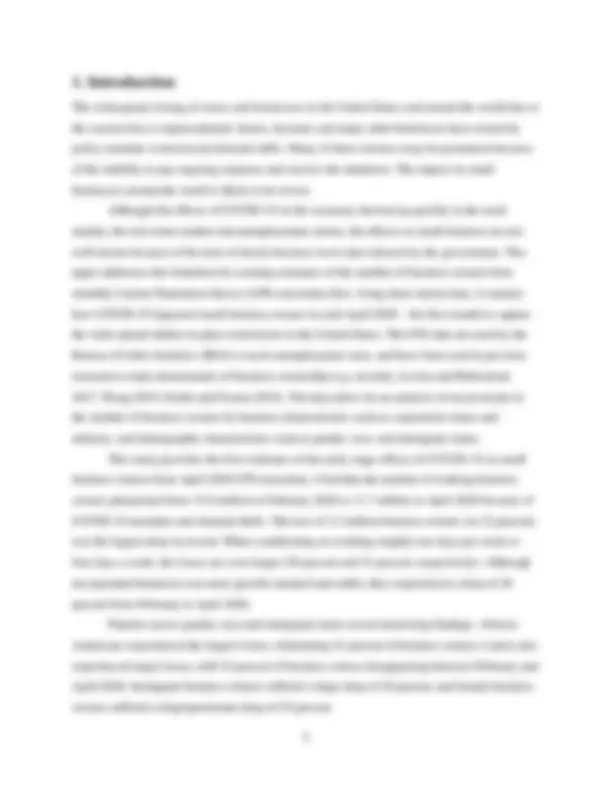
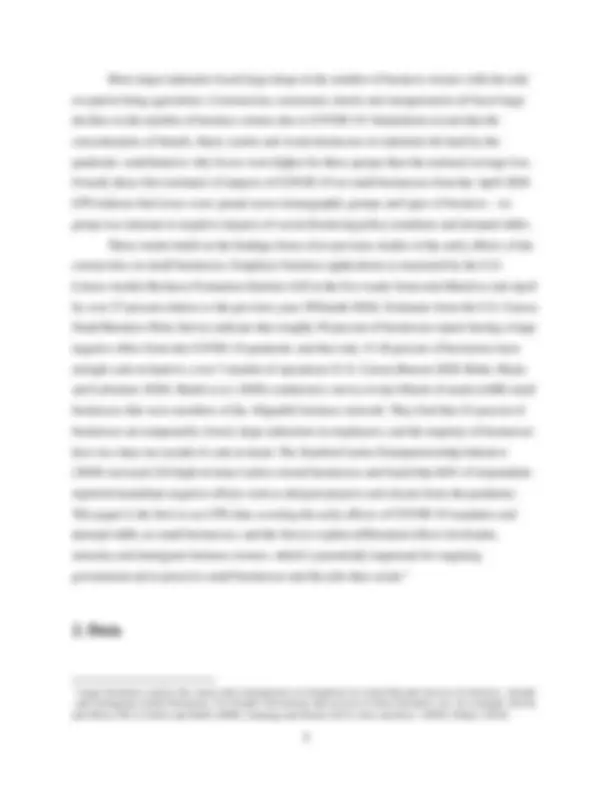
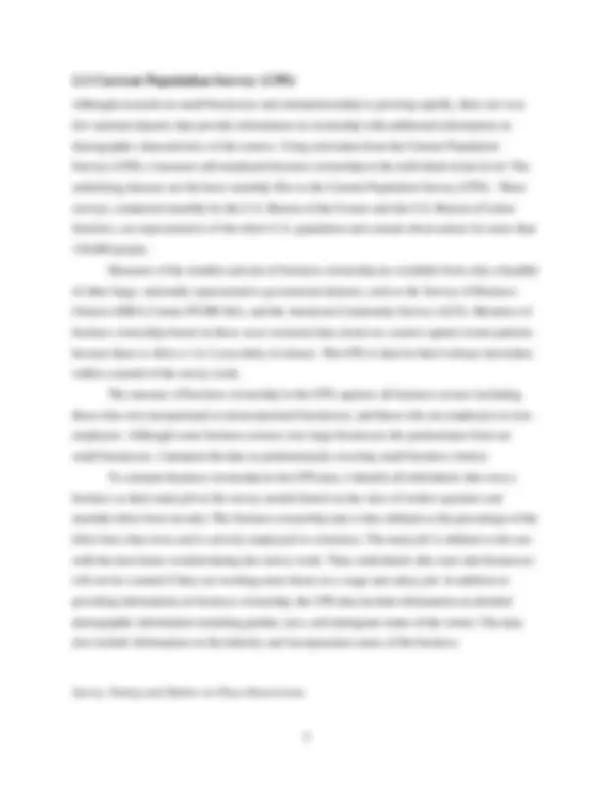
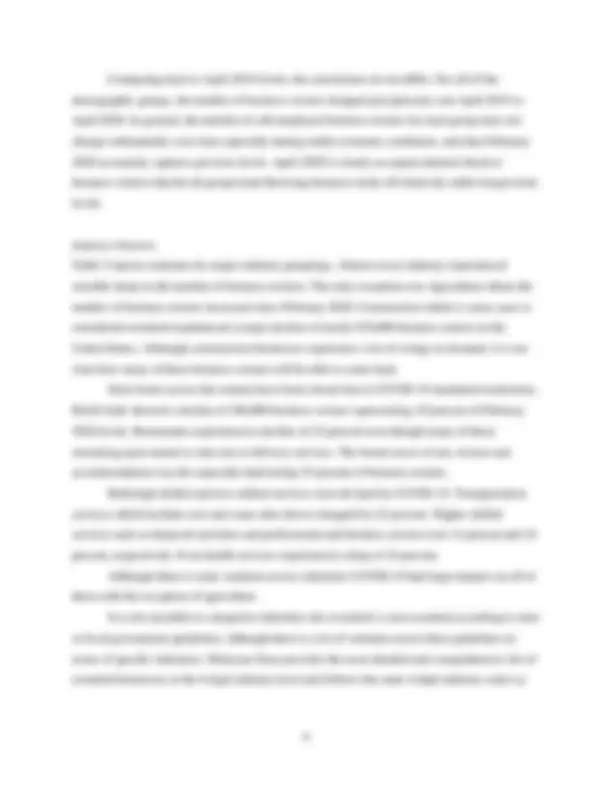
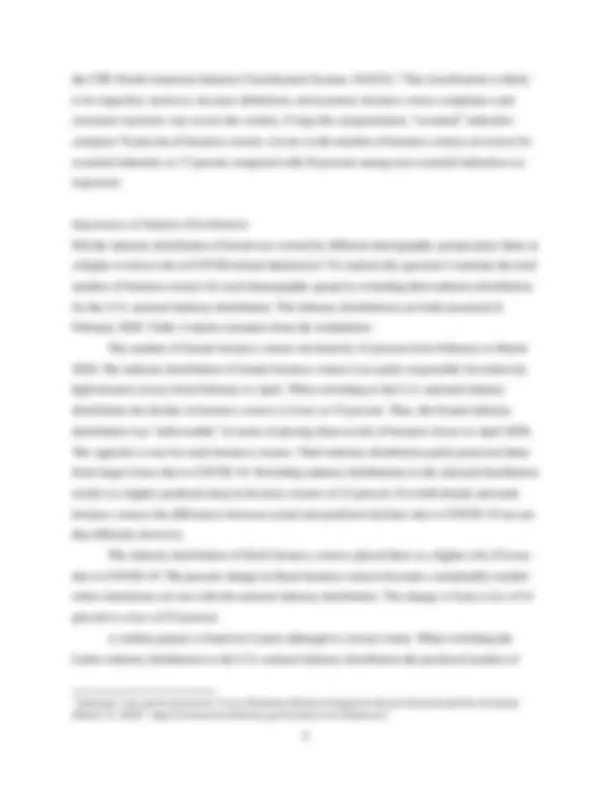
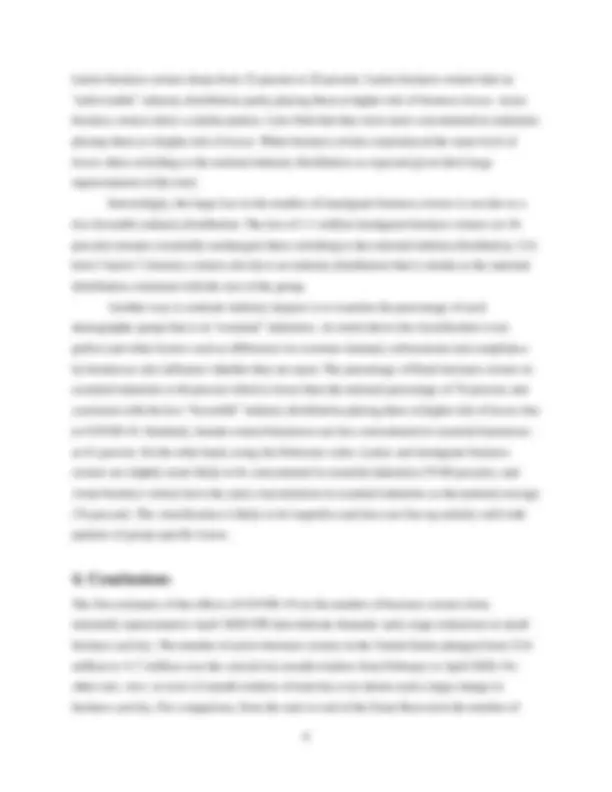
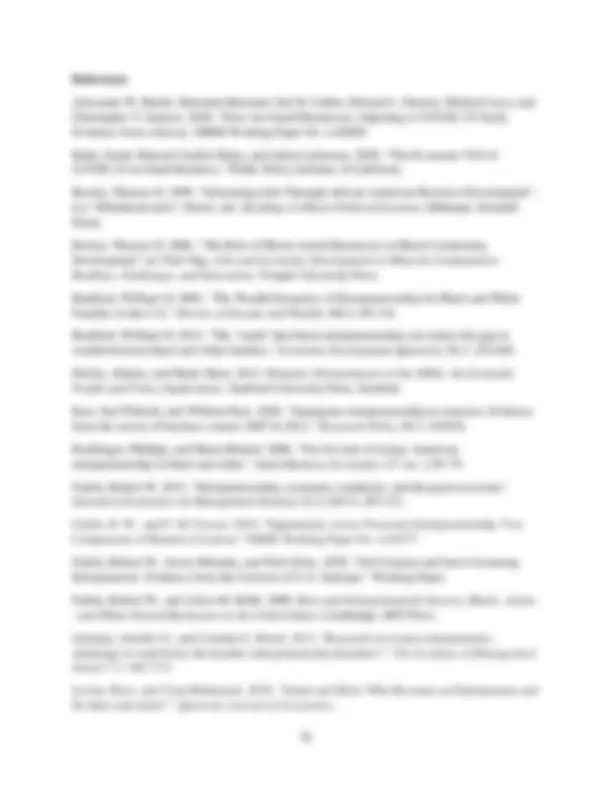
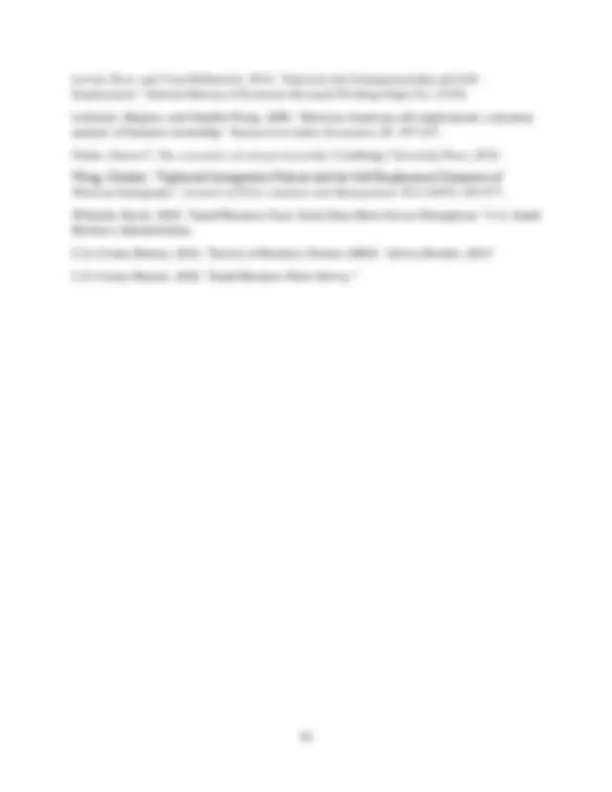
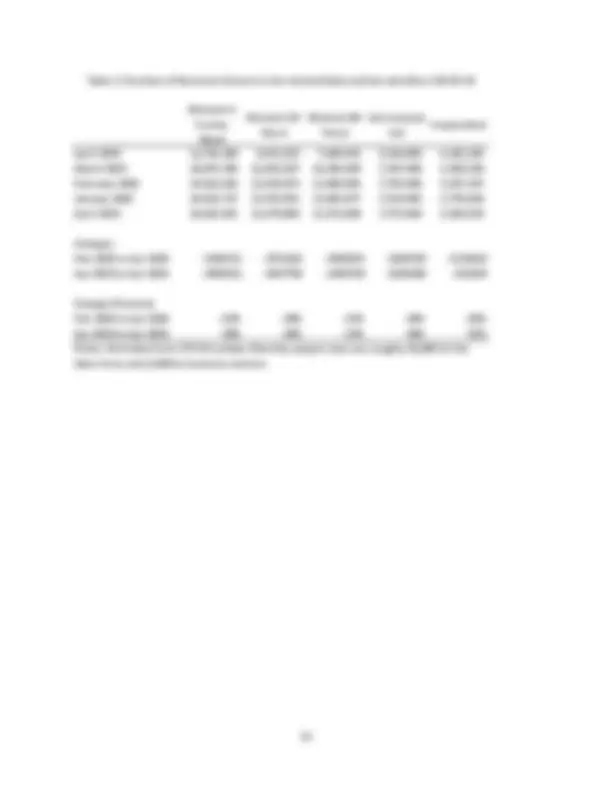
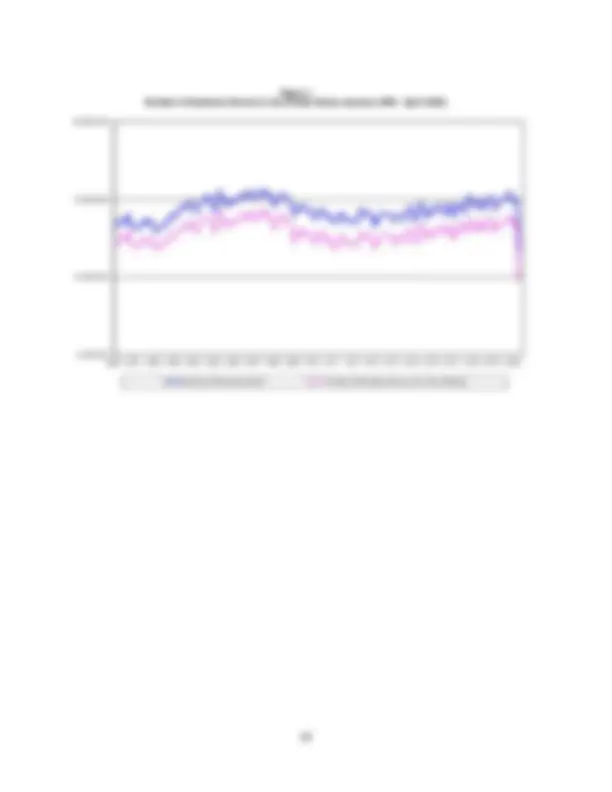
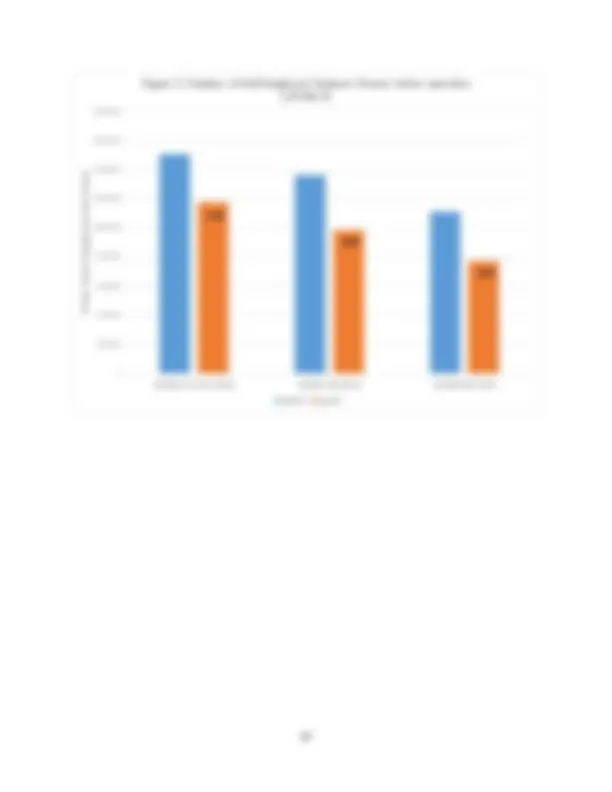
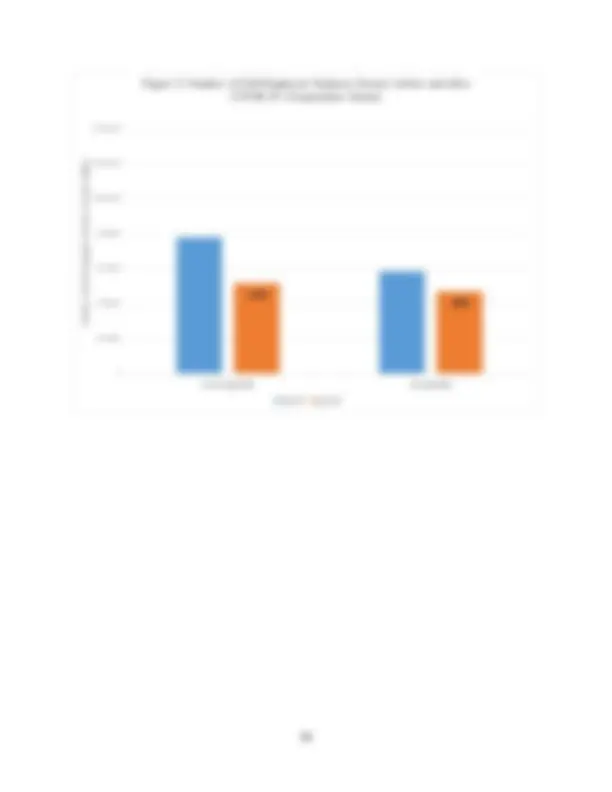
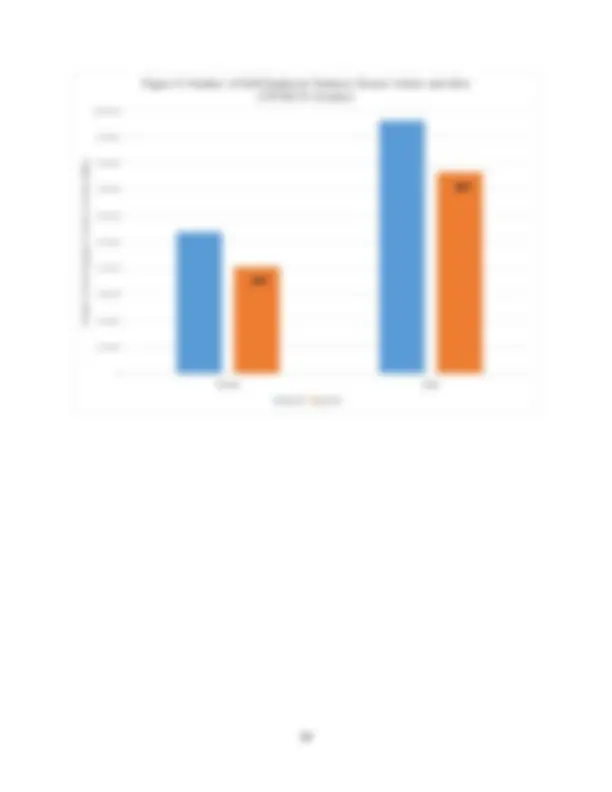
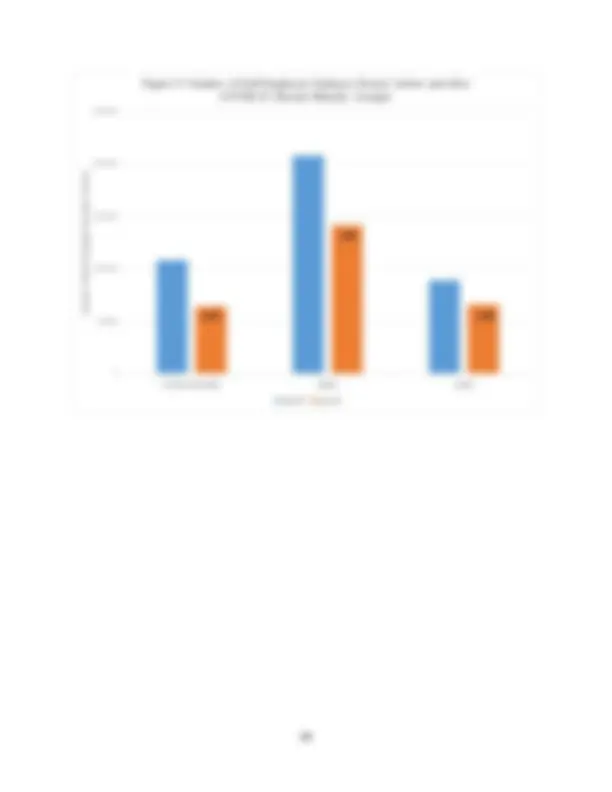
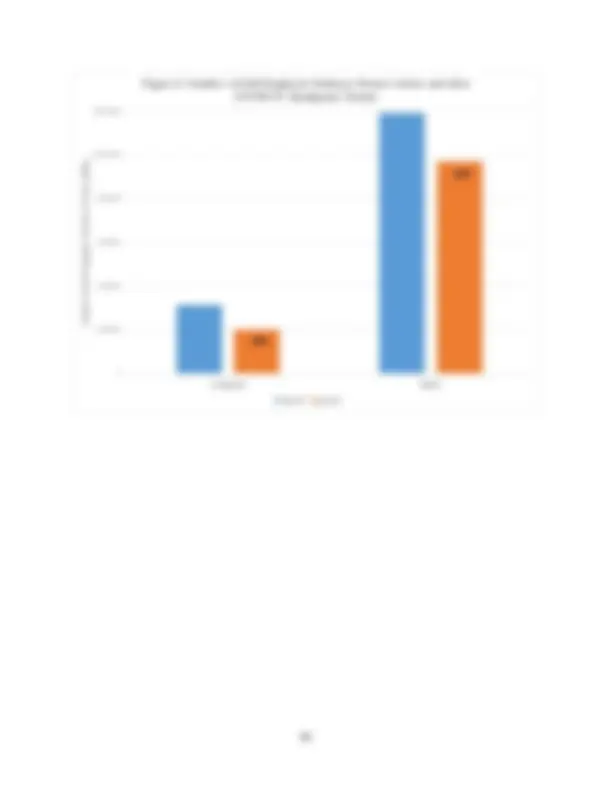


Study with the several resources on Docsity

Earn points by helping other students or get them with a premium plan


Prepare for your exams
Study with the several resources on Docsity

Earn points to download
Earn points by helping other students or get them with a premium plan
Community
Ask the community for help and clear up your study doubts
Discover the best universities in your country according to Docsity users
Free resources
Download our free guides on studying techniques, anxiety management strategies, and thesis advice from Docsity tutors
This document, authored by Robert Fairlie from the University of California, Santa Cruz and NBER, provides an early analysis of the effects of COVID-19 on small business owners using data from the April 2020 Current Population Survey. The study reveals a significant drop in the number of active business owners, particularly among demographic groups such as African-Americans, Latinx, and immigrants, and in industries like construction, restaurants, hotels, and transportation.
Typology: Summaries
1 / 23

This page cannot be seen from the preview
Don't miss anything!
















The Impact of Covid-19 on Small Business Owners: Evidence of Early- Stage Losses from the April 2020 Current Population Survey
Abstract
Social distancing restrictions and demand shifts from COVID-19 are expected to shutter many small businesses, but there is very little early evidence on impacts. This paper provides the first analysis of impacts of the pandemic on the number of active small businesses in the United States using nationally representative data from the April 2020 CPS – the first month fully capturing early effects from the pandemic. The number of active business owners in the United States plummeted by 3.3 million or 22 percent over the crucial two-month window from February to April 2020. The drop in business owners was the largest on record, and losses were felt across nearly all industries and even for incorporated businesses. African-American businesses were hit especially hard experiencing a 41 percent drop. Latinx business owners fell by 32 percent, and Asian business owners dropped by 26 percent. Simulations indicate that industry compositions partly placed these groups at a higher risk of losses. Immigrant business owners experienced substantial losses of 36 percent. Female-owned businesses were also disproportionately hit by 25 percent. These findings of early-stage losses to small businesses have important policy implications and may portend longer-term ramifications for job losses and economic inequality.
Keywords: Small business, entrepreneurship, self-employment, COVID-19, coronavirus, shelter in place, social distancing
JEL Codes: J15; J16; L
(^1) Department of Economics, University of California, Santa Cruz, Stanford University (Visiting Scholar), and NBER (rfairlie@ucsc.edu).
Most major industries faced large drops in the number of business owners with the only exception being agriculture. Construction, restaurants, hotels and transportation all faced large declines in the number of business owners due to COVID-19. Simulations reveal that the concentrations of female, black, Latinx and Asian businesses in industries hit hard by the pandemic contributed to why losses were higher for these groups than the national average loss. Overall, these first estimates of impacts of COVID-19 on small businesses from the April 2020 CPS indicate that losses were spread across demographic groups and types of business – no group was immune to negative impacts of social distancing policy mandates and demand shifts. These results build on the findings from a few previous studies of the early effects of the coronavirus on small businesses. Employer business applications as measured by the U.S. Census weekly Business Formation Statistics fell in the five weeks from mid-March to md-April by over 27 percent relative to the previous year (Wilmoth 2020). Estimates from the U.S. Census Small Business Pulse Survey indicate that roughly 50 percent of businesses report having a large negative effect from the COVID-19 pandemic and that only 15-20 percent of businesses have enough cash on hand to cover 3 months of operations (U.S. Census Bureau 2020; Bohn, Mejia and Lafortune 2020). Bartik et al. (2020) conducted a survey in late March of nearly 6,000 small businesses that were members of the Alignable business network. They find that 43 percent of businesses are temporarily closed, large reductions in employees, and the majority of businesses have less than one month of cash on hand. The Stanford Latino Entrepreneurship Initiative (2020) surveyed 224 high-revenue Latinx-owned businesses and found that 86% of respondents reported immediate negative effects such as delayed projects and closure from the pandemic. This paper is the first to use CPS data covering the early effects of COVID-19 mandates and demand shifts on small businesses, and the first to explore differential effects for female, minority and immigrant business owners, which is potentially important for targeting government aid to preserve small businesses and the jobs they create.^1
2. Data
(^1) Large literatures explore the causes and consequences of disparities in ownership and success of minority-, female- , and immigrant-owned businesses. For broader discussions and reviews of these literature, see, for example, Davila and Mora (2013); Fairlie and Robb (2008); Jennings and Brush (2013); Kerr and Kerr. (2020); Parker (2018).
Although research on small businesses and entrepreneurship is growing rapidly, there are very few national datasets that provide information on ownership with additional information on demographic characteristics of the owners. Using microdata from the Current Population Surveys (CPS), I measure self-employed business ownership at the individual owner level. The underlying datasets are the basic monthly files to the Current Population Survey (CPS). These surveys, conducted monthly by the U.S. Bureau of the Census and the U.S. Bureau of Labor Statistics, are representative of the entire U.S. population and contain observations for more than 130,000 people. Measures of the number and rate of business ownership are available from only a handful of other large, nationally representative government datasets, such as the Survey of Business Owners (SBO), Census PUMS files, and the American Community Survey (ACS). Measures of business ownership based on these cross-sectional data, however, cannot capture recent patterns because there is often a 1 to 2 year delay in release. The CPS is ideal in that it release microdata within a month of the survey week. The measure of business ownership in the CPS captures all business owners including those who own incorporated or unincorporated businesses, and those who are employers or non- employers. Although some business owners own large businesses the predominate form are small businesses. I interpret the data as predominately covering small business owners. To estimate business ownership in the CPS data, I identify all individuals who own a business as their main job in the survey month (based on the class of worker question and monthly labor force recode). The business ownership rate is thus defined as the percentage of the labor force that owns and is actively employed in a business. The main job is defined as the one with the most hours worked during the survey week. Thus, individuals who start side businesses will not be counted if they are working more hours on a wage and salary job. In addition to providing information on business ownership, the CPS data include information on detailed demographic information including gender, race, and immigrant status of the owner. The data also include information on the industry and incorporation status of the business.
Survey Timing and Shelter-in-Place Restrictions
unprecedented. Conditioning on 30 or more hours worked results in losses of 3.4 million or 31 percent (see Table 1). Separating the number of business owners into unincorporated and incorporated status indicates large drops for both groups (see Table 1). Incorporated businesses are viewed as more growth- oriented, committed, pro-cyclical and entrepreneurial (e.g. Fairlie, Miranda and Zolas 2020; Levine and Rubinstein 2016, 2018). The number of unincoporated business owners dropped precipitously from 7.8 million to 5.1 million (34 percent). But, incorporated business owners were not immune to the COVID-19 impacts. The number of incorporated business owners in the United States dropped from 5.8 million to 4.7 million (20 percent).
Demographic Patterns The CPS data provide detailed information on gender, race and immigrant status. Figure 3 (Table
Comparing back to April 2019 levels, the conclusions do not differ. For all of the demographic groups, the number of business owners dropped precipitously rom April 2019 to April 2020. In general, the number of self-employed business owners for each group does not change substantially over time especially during stable economic conditions, and thus February 2020 accurately captures previous levels. April 2020 is clearly an unprecedented shock to business owners that hit all groups hard throwing business totals off relatively stable longer-term levels.
Industry Patterns Table 3 reports estimates by major industry groupings. Almost every industry experienced sizeable drops in the number of business owners. The only exception was Agriculture where the number of business owners increased since February 2020. Construction which is some cases is considered essential experienced a major decline of nearly 670,000 business owners in the United States. Although construction businesses experience a lot of swings in demand, it is not clear how many of these business owners will be able to come back. Store fronts across the country have been closed due to COVID-19 mandated restrictions. Retail trade showed a decline of 108,000 business owners representing 10 percent of February 2020 levels. Restaurants experienced a decline of 22 percent even though many of those remaining open turned to take-out or delivery services. The broad sector of arts, leisure and accommodations was hit especially hard losing 35 percent of business owners. Both high-skilled and less-skilled services were hit hard by COVID-19. Transportation services which includes taxi and some uber drivers dropped by 22 percent. Higher-skilled services such as financial activities and professional and business services lost 12 percent and 18 percent, respectively. Even health services experienced a drop of 16 percent. Although there is some variation across industries COVID-19 had large impacts on all of them with the exception of agriculture. It is also possible to categorize industries into essential vs non-essential according to state or local government guidelines, although there is a lot of variation across these guidelines in terms of specific industries. Delaware State provides the most detailed and comprehensive list of essential businesses at the 4-digit industry level and follows the same 4-digit industry codes as
Latinx business owners drops from 32 percent to 28 percent. Latinx business owners had an “unfavorable” industry distribution partly placing them at higher risk of business losses. Asian business owners show a similar pattern. I also find that they were more concentrated in industries placing them at a higher risk of losses. White business owners experienced the same level of losses when switching to the national industry distribution as expected given their large representation of the total. Interestingly, the large loss in the number of immigrant business owners is not due to a less favorable industry distribution. The loss of 1.1 million immigrant business owners (or 36 percent) remains essentially unchanged when switching to the national industry distribution. U.S. born (“native”) business owners also have an industry distribution that is similar to the national distribution consistent with the size of the group. Another way to estimate industry impacts is to examine the percentage of each demographic group that is in “essential” industries. As noted above the classification is not perfect and other factors such as differences in customer demand, enforcement and compliance by businesses also influence whether they are open. The percentage of black business owners in essential industries is 66 percent which is lower than the national percentage of 76 percent, and consistent with the less “favorable” industry distribution placing them at higher risk of losses due to COVID-19. Similarly, female-owned businesses are less concentrated in essential businesses at 61 percent. On the other hand, using the Delaware codes, Latinx and immigrant business owners are slightly more likely to be concentrated in essential industries (79-80 percent), and Asian business owners have the same concentration in essential industries as the national average (76 percent). The classification is likely to be imperfect and does not line up entirely well with patterns of group-specific losses.
4. Conclusions
The first estimates of the effects of COVID-19 on the number of business owners from nationally representative April 2020 CPS data indicate dramatic early-stage reductions in small business activity. The number of active business owners in the United States plunged from 15. million to 11.7 million over the crucial two-month window from February to April 2020. No other one-, two- or even 12-month window of time has ever shown such a large change in business activity. For comparison, from the start to end of the Great Recession the number of
business owners decreased by 730,000 representing only a 5 percent reduction. In general, business ownership is relatively steady over the business cycle (Fairlie 2013; Parker 2018). The loss of 3.3 million business owners (or 22 percent) was comprised of large drops in important subgroups such as owners working roughly two days per week (28 percent), owners working four days a week (31 percent), and incorporated businesses (20 percent). African-American businesses were hit the hardest by COVID-19. The first estimates from April 2020 for black business owners in the United States indicate a massive drop of 41 percent. Simulations indicate that the industry distribution of blacks was partly responsible placing black business owners at greater risk of losses due to the pandemic. Latinx businesses were also hit hard by COVID-19 losing 32 percent of business owners. Asian business owners experienced a 26 percent decline over the critical two-month window. Simulation estimates also point to unfavorable industry distributions for these two groups. Immigrant businesses were also devastated with losses of 36 percent. The negative early-stage impacts on minority- and immigrant-owned businesses, if prolonged, may be problematic for broader racial inequality because of the importance of minority businesses for local job creation (disproportionately for other minorities), economic advancement, and longer-term wealth inequality (Boston 1999, 2006; Bradford 2003, 2014; Fairlie and Robb 2008). The first estimates of early stage impacts on female-owned businesses are also worrisome. Female business ownership is substantially lower than male business ownership and female-owned businesses have lower revenues, employees and profits on average (U.S. Census Bureau 2016). The disproportionate losses in April 2020 to the number of female business owners will only further increase gender inequality in business ownership and perhaps broader economic inequality. The next important question is whether the shutdowns of small businesses are temporary or longer term. The government has been responding to concerns over longer-term effects on small businesses through several programs. The largest directed program is the Paycheck Protection Program (PPP) which has thus far provided $669 billion to small businesses (although with some controversy when businesses such as Ruth’s Chris Steak House, Potbelly Sandwich Shops, and the Lakers received approval for funds). Another program that is less directed but also could be important are stimulus checks already totaling $200 billion. Foundations are also starting to contribute to relief efforts with a notable recent example being a $100 million
References
Alexander W. Bartik, Marianne Bertrand, Zoë B. Cullen, Edward L. Glaeser, Michael Luca, and Christopher T. Stanton. 2020. “How Are Small Businesses Adjusting to COVID-19? Early Evidence from a Survey. NBER Working Paper No. w26989.
Bohn, Sarah, Marisol Cuellar Mejia, and Julien Lafortune. 2020. “The Economic Toll of COVID-19 on Small Business,” Public Policy Institute of California.
Boston, Thomas D. 1999. “Generating Jobs Through African American Business Development”, in J. Whitehead and C. Harris, eds_. Readings in Black Political Economy_ (Dubuque: Kendall- Hunt).
Boston, Thomas D. 2006. “The Role of Black-owned Businesses in Black Community Development” ed. Paul Ong, Jobs and Economic Development in Minority Communities: Realities, Challenges, and Innovation. Temple University Press
Bradford, William D. 2003. "The Wealth Dynamics of Entrepreneurship for Black and White Families in the U.S.," Review of Income and Wealth , 49(1): 89-116. Bradford, William D. 2014. "The “myth” that black entrepreneurship can reduce the gap in wealth between black and white families." Economic Development Quarterly 28.3: 254-269.
Dávila, Alberto, and Marie Mora. 2013. Hispanic Entrepreneurs in the 2000s: An Economic Profile and Policy Implications. Stanford University Press, Stanford.
Kerr, Sari Pekkala, and William Kerr. 2020. "Immigrant entrepreneurship in America: Evidence from the survey of business owners 2007 & 2012." Research Policy 49.3: 103918.
Koellinger, Phillipp, and Maria Minniti. 2006. "Not for lack of trying: American entrepreneurship in black and white." Small Business Economics 27, no. 1:59–79.
Fairlie, Robert W. 2013. "Entrepreneurship, economic conditions, and the great recession." Journal of Economics & Management Strategy 22.2 (2013): 207-231.
Fairlie, R. W., and F. M. Fossen. 2019. "Opportunity versus Necessity Entrepreneurship: Two Components of Business Creation." NBER Working Paper No. w26377.
Fairlie, Robert W., Javier Miranda, and Nick Zolas. 2020. “Job Creation and Survival among Entrepreneurs: Evidence from the Universe of U.S. Startups,” Working Paper.
Fairlie, Robert W., and Alicia M. Robb. 2008. Race and Entrepreneurial Success: Black-, Asian- , and White-Owned Businesses in the United States , Cambridge: MIT Press.
Jennings, Jennifer E., and Candida G. Brush. 2013. "Research on women entrepreneurs: challenges to (and from) the broader entrepreneurship literature?." The Academy of Management Annals 7.1: 663-715.
Levine, Ross, and Yona Rubinstein. 2016. "Smart and Illicit: Who Becomes an Entrepreneur and Do they earn more?." Quarterly Journal of Economics.
Levine, Ross, and Yona Rubinstein. 2018. "Selection into Entrepreneurship and Self- Employment." National Bureau of Economic Research Working Paper No. 25350.
Lofstrom, Magnus, and Chunbei Wang. 2009. "Mexican-American self-employment: a dynamic analysis of business ownership." Research in Labor Economics 29: 197-227.
Parker, Simon C. The economics of entrepreneurship. Cambridge University Press, 2018. Wang, Chunbei. "Tightened Immigration Policies and the Self‐Employment Dynamics of Mexican Immigrants." Journal of Policy Analysis and Management 38.4 (2019): 944-977.
Wilmoth, David. 2020. “Small Business Facts: Early Data Show Severe Disruptions,” U.S. Small Business Administration.
U.S. Census Bureau. 2016. “Survey of Business Owners (SBO) - Survey Results: 2012”
U.S. Census Bureau. 2020. “Small Business Pulse Survey.”
Feb. 2020 Apr 2020 Group Number Number Number % Change Number % Change Total 15,012,692 11,710,360 -3,302,331 -22% -3,302,331 -22% Female 5,389,399 4,048,205 -1,341,194 -25% -1,029,305 -19% Male 9,623,293 7,662,156 -1,961,137 -20% -2,184,231 -23% Black 1,079,116 637,769 -441,347 -41% -379,452 -35% Latinx 2,070,896 1,412,925 -657,971 -32% -583,009 -28% Asian 888,528 657,896 -230,632 -26% -195,041 -22% White 10,553,415 8,761,531 -1,791,884 -17% -1,928,907 -18% Immigrant 3,120,275 2,009,597 -1,110,677 -36% -1,095,536 -35% Native 11,892,417 9,700,763 -2,191,654 -18% -2,256,417 -19%
Business Losses (Feb. to April 2020) Actual Losses
Predicted using U.S. Industry Distribution
Notes: Estimates are from CPS microdata. Predicted changes swith the group's industry distribution for the U.S. industry distribution but continue to use the group's rate of change from February to April 2020.
Table 2: Demographic Group Losses and Simulations of Business Losses from Switching Industry Distributions
Industry April 2020
Change from Feb. 2020
Percent Change February 2020
Percent in Feb. 2020 Agriculture 928,156 58494 7% 869,661 6% Construction 1,768,875 -667182 -27% 2,436,057 16% Manufacturing 506,019 -60174 -11% 566,192 4% Retail Trade 960,872 -107612 -10% 1,068,484 7% Transportation 624,498 -173827 -22% 798,325 5% Financial activities 1,149,105 -152665 -12% 1,301,769 9% Professional and bus. 2,695,136 -600739 -18% 3,295,875 22% Health services 1,034,240 -204094 -16% 1,238,335 8% Arts, leisure, hotels 442,964 -242045 -35% 685,009 5% Restaurants 319,194 -90411 -22% 409,605 3% Repair and maintenance 385,400 -127003 -25% 512,403 3% All other industries 895,901 -935074 -51% 1,830,976 12%
"Nonessential" industry 2,292,949 -1382990 -38% 3,675,939 24% "Essential" Industry 9,417,411 -1919342 -17% 11,336,752 76% Notes: Estimates from CPS microdata. Essential industries are defined using the classification provided by Delaware State for essential and nonessential businesses.
Table 3: Business Losses by Selected Industries from COVID-
0
2,000,
4,000,
6,000,
8,000,
10,000,
12,000,
14,000,
16,000,
18,000,
Worked in Survey Week Worked 15+ Hours Worked 30+ Hours
Number of Self
Figure 2: Number of Self-Employed Business Owners before and after COVID- 19
Feb-20 Apr-
0
2,000,
4,000,
6,000,
8,000,
10,000,
12,000,
14,000,
Unincorporated Incoporated
Number of Self
Figure 3: Number of Self-Employed Business Owners before and after COVID-19 (Corporation Status)
Feb-20 Apr-